Violence Against Jews Preceding Modern Israel
The Arab violence against Jews in the region have deep historical roots and dates back to Prophet Muhammad and the birth of Islam.
In this blog post we will delve into some key instances of violence against Jews that predated the establishment of the modern state of Israel in 1948.
The 1947 Jerusalem Riots
In late 1947, as the United Nations debated the partition of Mandatory Palestine into separate Jewish and Arab states, violence erupted in Jerusalem. At this time 100,000 Jews lived in Jerusalem, 33,000 Muslims & 31,000 Christians. Arab rioters targeted Jews in the city, leading to dozens of deaths and the dislocation and ethnical cleansing of the Jewish quarter, communities that lived there for thousands of years.
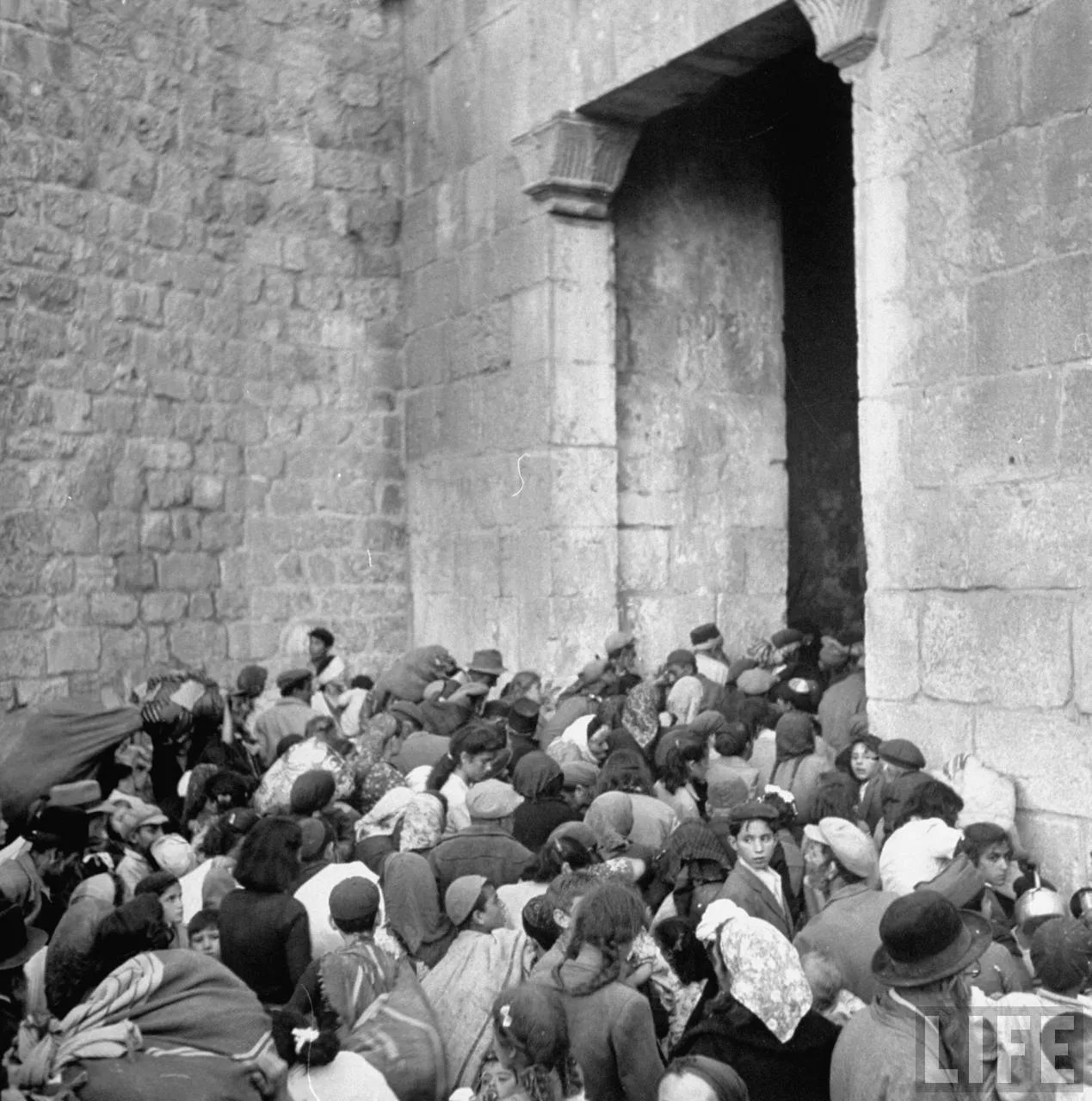 Residents leaving the Jewish Quarter by way of Zion Gate, 1948. Photograph: John Phillips. From: the exhibition "Alone on the Walls"
Residents leaving the Jewish Quarter by way of Zion Gate, 1948. Photograph: John Phillips. From: the exhibition "Alone on the Walls"
1941 The meeting of The Mufti of Jerusalem, Amin al-Husseini, with Hitler
Amin al-Husseini, the Grand Mufti of Jerusalem and a Palestinian nationalist leader, met with Adolf Hitler on November 28, 1941, during World War II. During their meeting, al-Husseini sought Hitler's support and cooperation in eliminating the Jews in Israel and the Arab world, which was promised to him when the Nazi armies had defeated Russia and broken through the Caucasus into the Middle East.
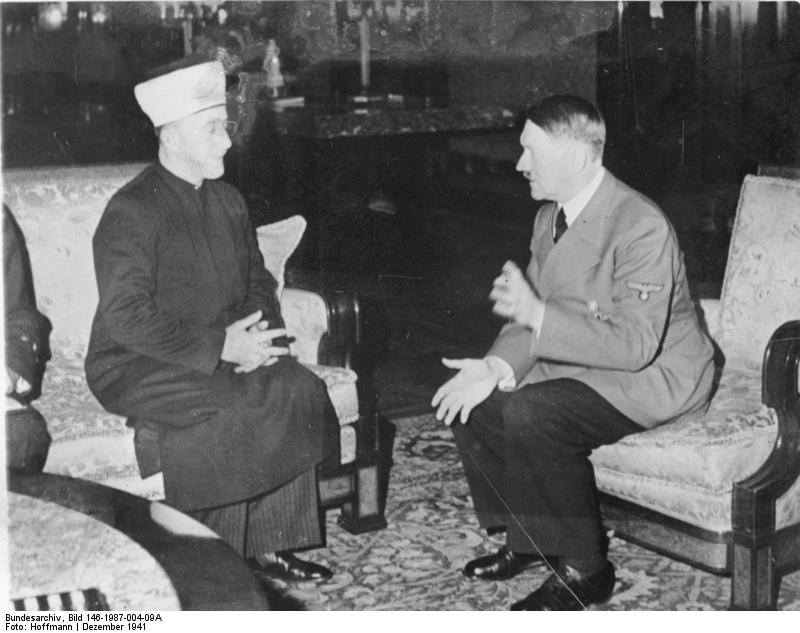 Haj Amin al-Husseini meeting with Adolf Hitler (28 November 1941)
Haj Amin al-Husseini meeting with Adolf Hitler (28 November 1941)
1938 Tiberias Massacre
On October 2, 1938, at nightfall Arabs strategically obstructed all routes leading to the Jewish city Tiberias with large rocks. At 21:00 a barrage of gunfire erupted from multiple directions, raining down upon the city. A group of 70 armed Arabs infiltrated the city from the north-east, they entered a residential neighborhood and went house to house, killing anyone they found and burning the houses and a local synagogue. 19 Jews were slaughtered, 11 of them were children.
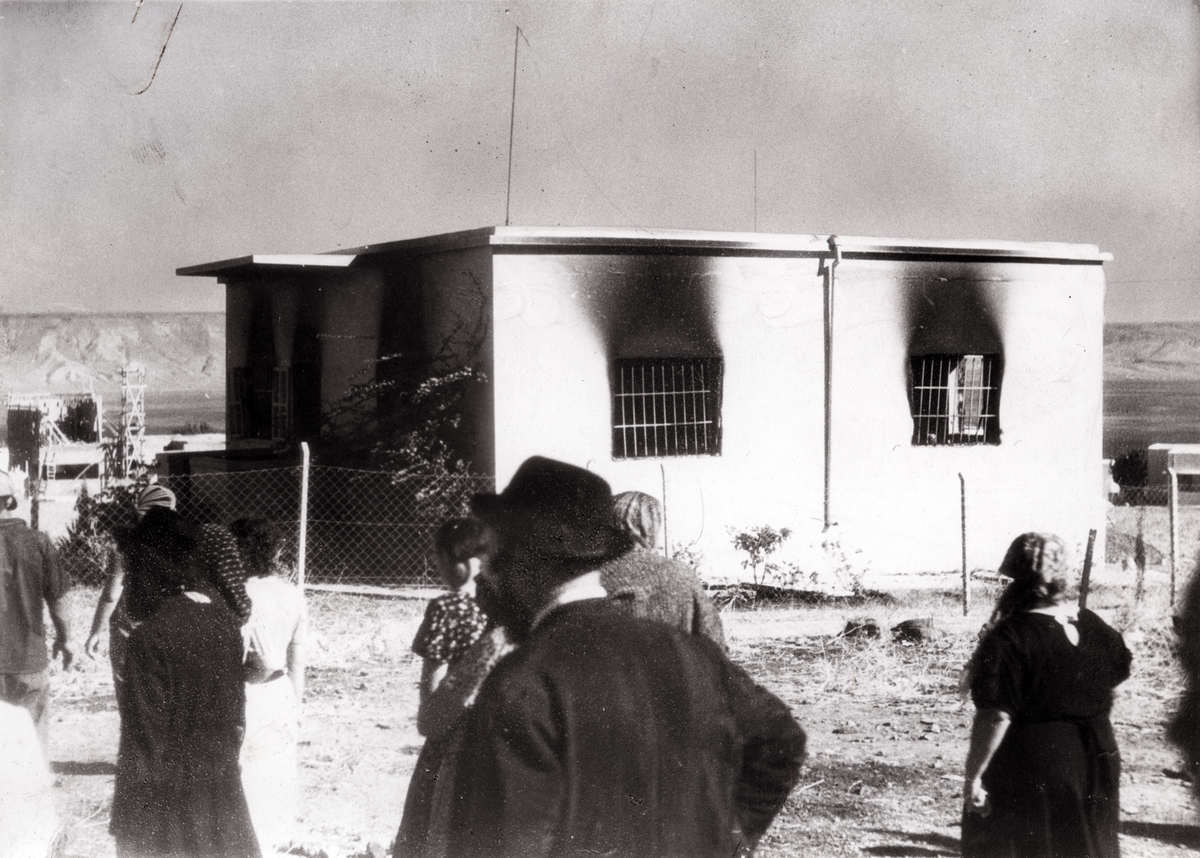 1938, house in the vicinity of Tiberias in which a Jewish family was burned alive by Arab insurgents. Dutch National Archives. Het Leven (LEVEN 022). Photo ID. SFA022823874
1938, house in the vicinity of Tiberias in which a Jewish family was burned alive by Arab insurgents. Dutch National Archives. Het Leven (LEVEN 022). Photo ID. SFA022823874
The 1936–1939 Arab Revolt
This multi-year uprising against British Mandate rule and Jewish immigration witnessed widespread violence against Jews, British forces, and Jewish-owned property. The revolt, which began in 1936, included attacks, sabotage, and assassinations, which continued until 1939.
More than 400 Jews were murdered and some jewish communities were destroyed or dislocated, such as Shimon HaTzadik (known today as Sheikh Jarrah), Kfar Hashiloach (today part of Silwan), Ein Zeitim, Peki'in and jewish communities in Jaffa.
1933 Palestine Riots
A series of violent riots in Mandatory Palestine started on 13 October 1933 in Jerusalem and later that month spread to Jaffa, Haifa and Nablus. The riots targeted mainly the British authorities.
1929 Hebron Massacre
On Saturday, August 24, 1929, at about 8.30 am, the first attacks began to be launched against houses where Jews resided, after a crowd of Arabs, residents of Hebron and nearby villages, armed with staves, axes and knives appeared in the streets. They went door to door, raping the women, slaughtering everyone who was inside, looting and burning.
Gershon Ben-Zion, for example, the Beit Hadassah Clinic pharmacist, a cripple who had served both Jews and Arabs for 4 decades, was forced to watch his daughter raped by dozens of rioters and then murdered. He was tortured to death. His wife's hands were cut off, and she died in excruciating agony.
The massacre, characterized by extreme brutality, resulted in the death of 67 Jews, 65 were injured, 44 of them severely. It has also led to the dislocation and ethnical cleansing of all Jewish communities from Hebron, bringing an end to the uninterrupted Jewish presence in Hebron dating back 1000s of years to the times of the Kingdom of Israel.
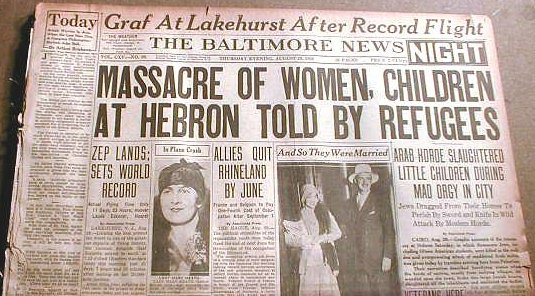
1929 Palestine Riots
The 1929 Palestine riots were a series of violent events that erupted in British Mandate Palestine between the 23rd and 29th of August. During the week of riots 133 Jews were killed by Arabs, including men, women, and children. Additional 339 Jews were injured. It also resulted in extensive damage to Jewish-owned properties. Homes, businesses, and religious institutions were ransacked, looted, and, in some cases, set ablaze, leaving many Jewish families displaced and economically devastated.
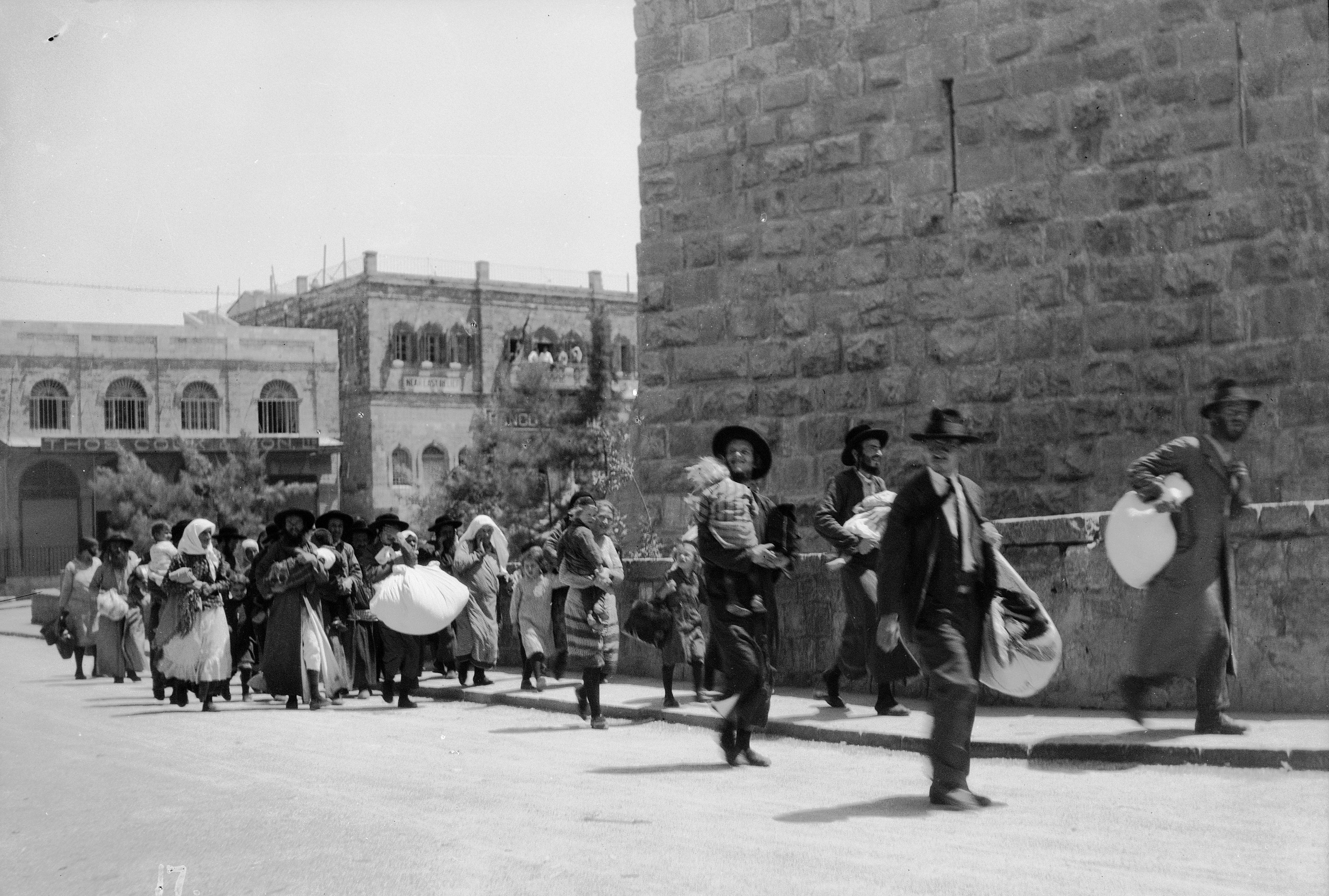 Jews flee the Old City of Jerusalem, August 1929
The Spielberg Jewish Film Archive - Aftermath of Arab Riots in 1929.
Jews flee the Old City of Jerusalem, August 1929
The Spielberg Jewish Film Archive - Aftermath of Arab Riots in 1929.
The 1921 Riots (Jaffa Riots)
In 1921, tensions between Jewish and Arab communities in Jaffa, a mixed city in British Mandate Palestine, erupted into violent riots. On May 1, 1921, the riots started by targeting Jewish passersby and looting Jewish shops on the markets, These clashes resulted in the deaths of 47 Jews with 140 wounded.
Additional Arab attacks occurred in nearby Rehovot, Kfar Saba, Petah Tikva, and Hadera.
1920 Nebi Musa Riots (Jerusalem Riots)
On Sunday, April 4, 1920, at the Nebi Musa festival, Amin al-Husseini and other Arab leaders incited the crowd of celebrants with heated hate speeches. As a result, after the traditional prayer at the end of the holiday, the crowd left the mosque to the Jewish homes in Old Jerusalem, shouting "Itbah al-Yahud" (slaughter the Jews). Jewish shops and homes were looted, Jews were attacked with with clubs, knives and stones, women were raped and synagogues destroyed and incinerated. 7 Jews were murdered, 216 injured, 18 of them seriously injured.
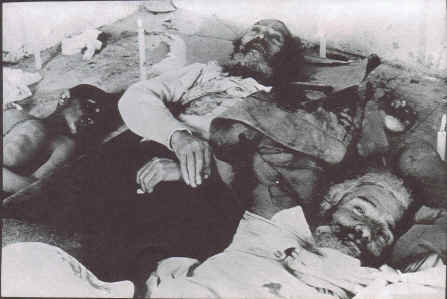
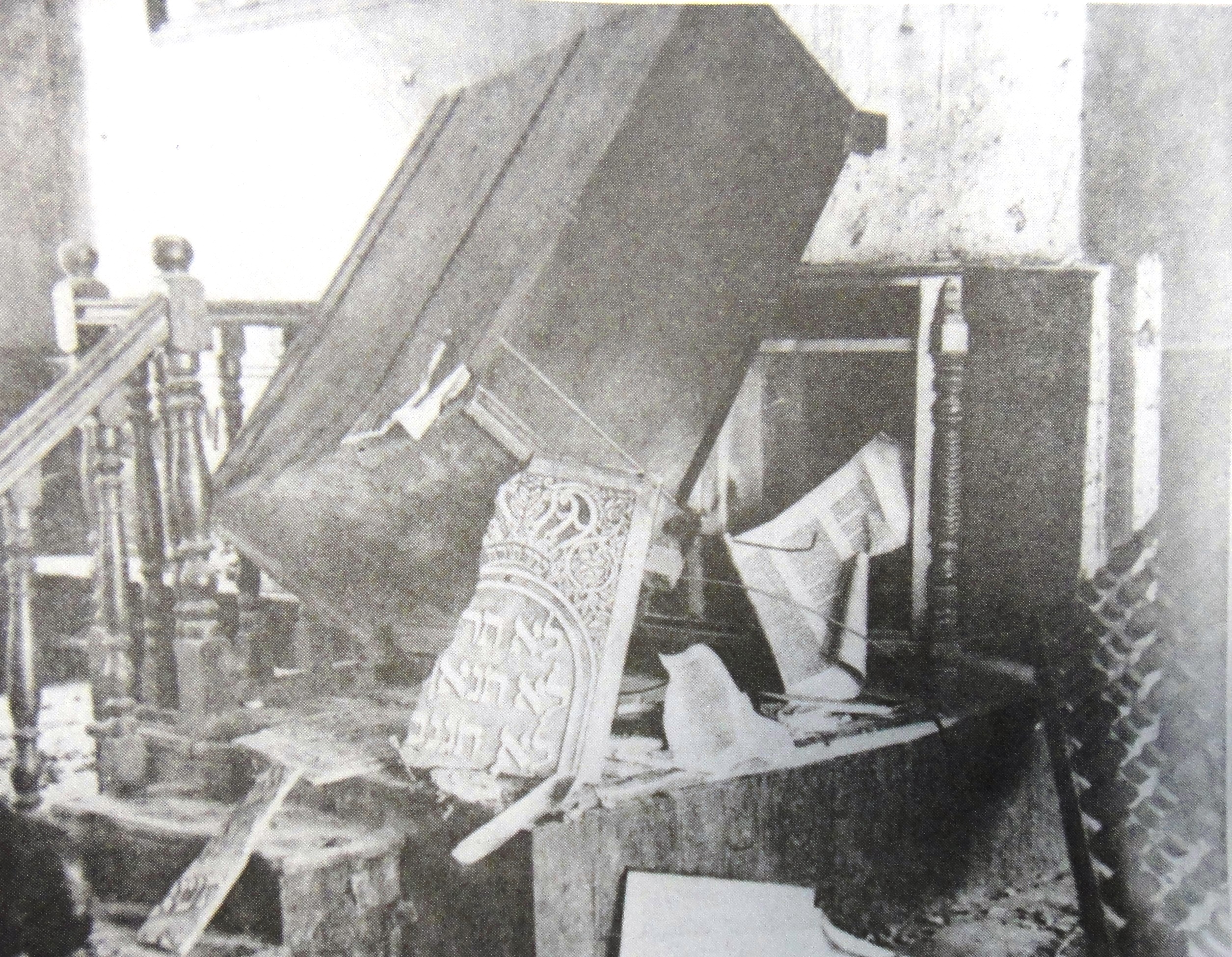 The pogrom in Torat Haim Yeshiva in Jerusalem 1920
The pogrom in Torat Haim Yeshiva in Jerusalem 1920
1920 Attack of Tel Hai
On March 1, 1920, several hundred Shiite Arabs from south Lebanon accompanied by Bedouin from the village Al-Khalisa, attacked the Jewish agricultural locality of Tel Hai. In the aftermath of the battle eight Jews were killed. The survivors of Tel Hai had no choice but to withdraw, whereupon the Arabs set fire to the village.
1908 Jaffa Riots
During the celebration of the Jewish holiday of Purim in Jaffa, Arab rioters attacked Jewish celebrants resulting in dozens of injuries.
1886 Petah Tikva Pogrom
On March 29, 1886, a group of 500 Arab men from neighboring villages, led by Sheikh Ottman, launched a violent attack on the Jewish village of Petah Tikva. The timing of the assault was strategic, as most of the village’s men were away in Jaffa, leaving behind mainly women, children, and a few elderly residents. Faced with the sudden attack, most of the Jewish villagers sought refuge in two fortified houses. While many managed to survive by sheltering within these strongholds, not all were so fortunate. Rabbi Aryeh Leib Frumkin, one of the founders of Petah Tikva, ventured outside to ensure that all villagers had reached shelter. Tragically, he was caught by the mob and brutally beaten unconscious. Another victim of the attack was Rachel Hadad Halevi, who had been ill and unable to reach shelter in time. She was severely beaten by the attackers and succumbed to her injuries a few days later.
1838 Druze Attack on Safed
On July 5, 1838, during the Druze revolt against the rule of Ibrahim Pasha of Egypt, the ruler of the area at that time, tensions were rising as the Druze captured an Egyptian garrison outside of Safed. Being outnumbered by the Druze the Egyptian garrison fled. The Druze rebels and a Muslim mob entered the city and descended on the Jewish quarter of Safed and, in scenes reminiscent of the Safed pogrom four years earlier, spent three days attacking Jews, plundering their homes and desecrating their synagogues.
1834 Hebron Massacre
In early August 1834, during the Peasants' revolt, the forces of Egypt lead by Ibrahim Pasha launched an assault against Hebron to crush the last pocket of significant resistance. After heavy street battles, the Egyptian Army defeated the rebels of Hebron and afterward subjected Hebron's inhabitants to violence following the fall of the city.
Although the Jews had not participated in the uprising and despite Ibrahim Pasha's assurances that the Jewish quarter would be left unharmed, Hebronite Jews were attacked. Jews were targeted for "special violence" and suffered the "most cruel outrages" from the hands of the Egyptian soldiers. 12 Jews were killed, Synagogues were desecrated, houses were ransacked and valuable items were stolen, leaving the Jewish community of Hebron destitute.
The 1834 Safed Pogrom
The 1834 Safed Pogrom, also known as The Great Looting of Safed, was a prolonged attack against the Jewish community of Safed during the Peasants' Revolt. The attack was perpetrated by Arabs, Muslims and Druze from nearby villages. It began on Sunday June 15 (7 Sivan), the day after the Jewish holiday of Shavuot, and lasted for the next 33 days. Taking advantage of a defenseless population, they engaged in a large scale looting, as well as killing and raping of Jews and the destruction of homes and synagogues. Many Torah scrolls were desecrated and many Jews were left severely wounded.
The 1850 account of Rabbi Joseph Schwartz stated that "Everything was carried off which could possibly be removed, even articles of no value; boxes, chests, packages, without even opening them, were dragged away; and the fury with which this crowd attacked their defenceless victims was boundless..."
1775 Hebron Blood Libel
In 1775, the Hebron Jewish community was rocked by a blood libel, in which Jews were falsely accused of murdering the son of a local sheikh. It provoked mob attacks on Jews. At first the Sheikh demanded to kill all the Jews but after pleas settled on a very large fine. The community which was in a shaky economic situation raised the money by donations from abroad.
1720 Burning of the Synagogue of Rabbi Yehudah Chassid (Jerusalem)
In 1720, the synagogue of Rabbi Yehudah HeChassid in Jerusalem, a central place of worship for the Ashkenazi Jewish community that was built on the ruins of a 15th century synagogue, was destroyed in a violent attack. Following mounting tensions and unpaid debts left by the community after Rabbi Yehudah HeChassid’s death, local creditors incited a mob to target the synagogue. The building was burned to the ground, and the remaining Ashkenazi Jews were expelled from Jerusalem and were prohibited from openly practicing their faith in the city. The ruins of the synagogue, later known as the "Hurva" (Hebrew for "ruin"), stood as a powerful symbol of the community's hardships until it was eventually rebuilt in the 19th century and destroyed again in 1948 by the Arab Legion.
1660 destruction of Safed
During the Druze power struggle in Mount Lebanon they destroyed Safed. The Jews of Safed had suffered severely and the inhabitants had fled with only a few of the former residents returned to the town after the destruction.
1660 Destruction of Tiberias
During the Druze power struggle in the Galilee they destroyed Tiberias resulting in the expulsion of the Jewish community. Tiberias lay in waste for decades.
1576 Deportation of Jews from Safed to Cyprus
The Sultan of the Ottoman Empire Murad III issued an edict for the forced deportation of 1,000 wealthy Jewish families from Safed to recently conquered Cyprus to boost the island's economy. A second one issued the following year for the removal of 500 families
1517 Safed Attacks
In the wake of the Ottoman conquest of Safed, when the town was still under the control of Mamluk forces, they initiated a violent riot against the Jewish community. Many Jews were killed and left injured, they were compelled to flee the city and their property was plundered.
1517 Hebron Attacks
The Ottoman Turks' conquest of the city in 1517 was marked by a violent pogrom which included many deaths, rapes, and the plundering of Jewish homes.
638-705 Al Aqsa Construction
In 638 Jerusalem was conquered by the Islamic Rashidun Caliphate who later became the Islamic Umayyad Caliphate. At some point during the Islamic rule a mosque was built on the temple mount on top of the ruines of the second Jewish temple, erasing the Jewish history of the site in the process. It was originally constructed from wood and then rebuilt from stone, The building was completed at around 705.
Al Aqsa is also known by the name Bayt al-Maqdis or Bayt al-Muqaddas (Arabic: بيت المقدس) which means House of the Temple. In Hebrew the Jewish temple is called Beit Hamikdash.
628 Battle of Khaybar
Khaybar, an oasis located 150 kilometres (93 mi) from the city of Medina was inhabitated by Jewish tribes. The spreading of Islam and the refusal of Jews to convert have caused conflicts between the Jews and Muslims. Earlier conflicts lead to Jewish tribes expulsion from the city of Medina, many of them settled in Khaybar.
Following a peace agreement between Muhammad and the residents of Mecca, Muhammad's leadership was undermined and he had to present his believers with a military achievement, so he chose to attack the Jewish tribes of Khaybar. When he saw that the Jews were interested in meeting with him for negotiations, he invited 30 Jewish leaders. While on the road and unarmed, a force of Muhammad believers attacked them and killed all but one who managed to escape. Thus the power of the tribes was greatly weakened.
In March 628, early Muslims led by Muhammad set out for Khaybar. The Jewish tribes lived in fortresses which the Muslims besieged and stormed until they surrendered. Many of the Jewish warriors died, the survivors were to evacuate the area and surrender their wealth. Some remained to cultivate their orchards for one-half of their produce until the final expulsion of all the Jews from the area in 642.
627 Massacre of Banu Qurayza
In the aftermath of the Battle of the Trench, Muhammad led his forces against the jewish tribe Banu Qurayza. They killed nearly all men (estimate 400-900) except some who converted to Islam, the women and children were sold for slavery.
625 Expulsion of Banu Nadir
The jewish tribe of Banu Nadir lived Yathrib (now called Medina). In 625 Muhammad besieged them and after 14 days siege and the burning and felling of their palm-trees they the were forced to surrender. Their land was taken and they were expelled allowing them to take only what they could carry on their camels. Most of Banu Nadir found refuge among the Jews of Khaybar.
624 Expulsion of Banu Qaynuqa
In the aftermath of Battle of Badr a dispute broke out between the Muslims and the Banu Qaynuqa, a jewish tribe residing in the city of Yathrib (now called Medina). Muhammad then besieged the Banu Qaynuqa for 14 or 15 days, after which the tribe surrendered unconditionally. Prophet Muhammad decided to expel them and divided their land and property among his followers.
Please note that the list provided only includes events that occurred in the region of Israel and its immediate vicinity, and it is not an exhaustive compilation.